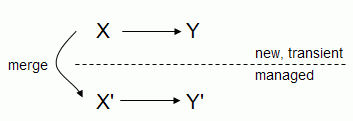Odi's astoundingly incomplete notes
New entries | CodeUpdates done right in EJB3
The EJB3 specs are very well designed. The decision to use it finally paid off!
I was facing the following problem: A structure of objects that is already present in the database needs to be updated with new data from memory. The structure is complex (a more complex graph than a tree) and has lots of relationships back and forth in the object model. The problem can not be solved by first deleting the existing data and then inserting the new data because the existing data is referenced to from other objects. (Some delete operations would lead to foreign key constraint violations.)
So it is necessary to use the
Let me illustrate this by the following diagram:

We start with X and Y which are two new, transient objects. X holds a reference to Y. After setting the ID and version of X and Y, merge is called on X. This creates a managed object X' which references a managed object Y'. Y' is automatically fetched from the database using the ID of Y. Now calling merge on Y will copy the data to the instance Y'. There is no need to manually relate X' and Y' again!
I was facing the following problem: A structure of objects that is already present in the database needs to be updated with new data from memory. The structure is complex (a more complex graph than a tree) and has lots of relationships back and forth in the object model. The problem can not be solved by first deleting the existing data and then inserting the new data because the existing data is referenced to from other objects. (Some delete operations would lead to foreign key constraint violations.)
So it is necessary to use the
EntityManager.merge operation. We have not defined any persistence cascading, so objects need to be merged one by one. For this to succeed it must be done like so in exactly this order:- Find existing persistent objects that corresonds to the new objects.
- Copy the primary key (ID fields) and version numbers of all persistent objects to the new objects. This effectively makes them detached entities.
- Merge all objects. The order is unimportant.
- Guaranteed object identity: Managed objects with the same primary key are identical instances.
- EntityManager.merge produces referenced entities that are managed: As outlined in section 3.2.4.1 of the persistence specs.
Let me illustrate this by the following diagram:

We start with X and Y which are two new, transient objects. X holds a reference to Y. After setting the ID and version of X and Y, merge is called on X. This creates a managed object X' which references a managed object Y'. Y' is automatically fetched from the database using the ID of Y. Now calling merge on Y will copy the data to the instance Y'. There is no need to manually relate X' and Y' again!
Add comment